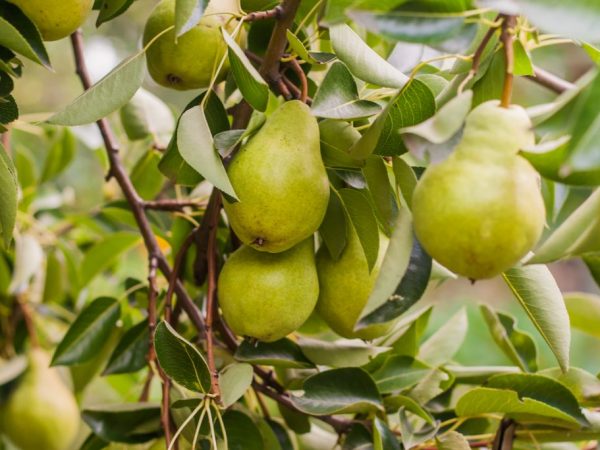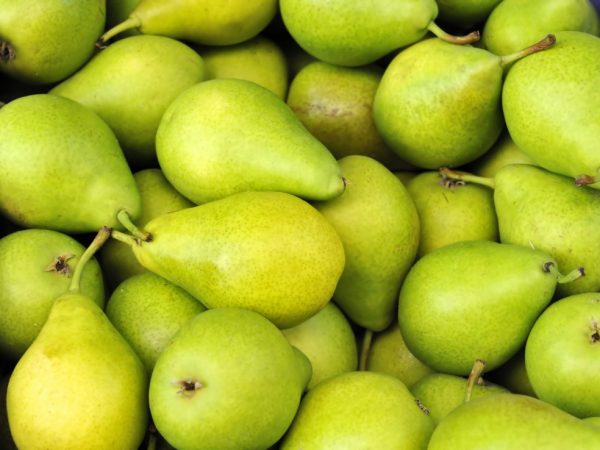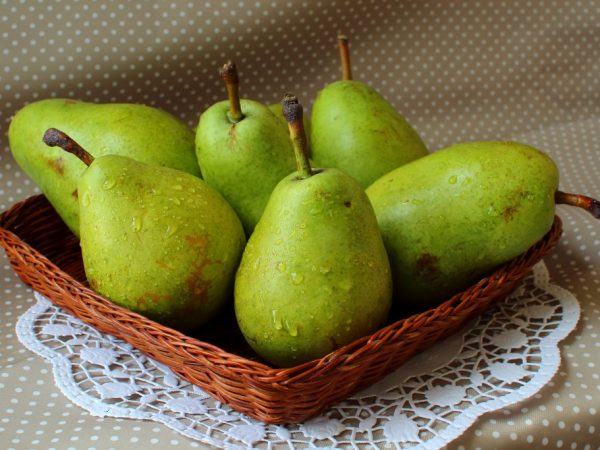Characteristics of the February Souvenir variety pear
Pear The February souvenir is a winter pear variety derived from the Talgar beauty and Daughter of the Dawn variety. They are characterized by high productivity, frost resistance.

Pear grade February Souvenir
Variety characteristic
Fertility is achieved in the fifth year after planting the seedling. The fruits ripen in mid-September, and the shelf life reaches 5 months.
Description of the tree
The tree grows tall, up to 20m, and strong. This species is characterized by an oval crown and medium density foliage.
Shoots are medium in size and green-brown in color, buds are small, conical in shape. Leaves are medium in size, green in color, smooth texture. In shape, they are curved towards the top, at the base they have a blunt shape, the petiole is medium.
Description of fruits
The description shows that the pears of the February Souvenir variety are medium in size, weighing about 140-160 grams, smooth and regular in shape. There is a slight waxy coating on the skin of the fruit. Fruit color is greenish-yellow. The pulp is white, not tight, delicate texture, aromatic, juicy, no astringency and granulation, sweet and sour.

Fruits are medium, weighing about 140-160 grams, smooth and regular in shape
Care
In order to prevent the roots of young trees from suffering in winter, it is necessary to insulate them with high quality. For example, sprinkle with additional snow, boles can be secured by wrapping them with foil. Try paper or sunflower leaves as an alternative to plastic.
Choosing a landing site
There are no strict requirements, but priority should be given to well-drained soils with good fertility. It is worth paying attention to a place in which there will be no stagnation of moisture.
It is better to choose a place for planting in the southern, southwestern or western part. A sunny side is encouraged, but not an open area. It is better to plant a tree in the off-season, mainly in the spring. Beware of adding fresh manure when planting, as due to prolonged fermentation, damage to the root part may occur.
Selection of seedlings
The appearance of the seedlings should be age appropriate:
- Annual plants grow up to a meter in height and have a formed trunk, three skeletal branches and formed buds.
- Biennial plants reach 1.5 m and more and have about five branches 50 cm long. When choosing seedlings, preference should be given to those whose branches have a slope of about 45 degrees to the trunk. With this inclination, the branches will not break under the weight of the fruit.
When choosing seedlings with a closed root, it is necessary to check the top of the root. To check, you can slightly pull the plant out of the pot with a lump, and if the earthen lump is densely intertwined with roots, and only young roots are visible from the drainage holes, in this case we have a representative with a well-developed root system.
Seedlings with open roots should be completely bald, and nascent buds are allowed.As a rule, two-year-old seedlings are chosen for planting, since they already have 7-8 branches on the sides.

With proper care of the pear, you can get a rich harvest.
Crown formation and pruning
The crown of the trees is oval. For good branching, the branches are shortened by a quarter of their length at the same height, but the conductor is always left 20-25 cm higher.For adult trees, it is enough as a preventive measure to remove small branches or tops that grow inward so as not to thicken the crown, as well as get rid of from broken branches.
Watering
The tree loves moderate watering. It is better to carry out "sprinkling". If this is not possible, then you can organize a ditch about 15 cm around the trunk, through which water will flow in moderation.
Loosening
The soil must be well drained and loosened, in order to allow air and moisture to enter, but the moisture should retain a little at the roots. This can be achieved by adding a little clay to the soil.
Top dressing and weed removal
Fertilize the tree in the second year, twice - in spring and autumn, summer top dressing is allowed. I carry out organic feeding once every three years, and mineral feeding once a year.
So that the near-trunk circles of young trees are not overgrown with weeds, you can sow green manure, which can then be used to enrich the soil.
Pests and diseases
The February Souvenir tree is not affected by scab and entomosporia.
With improper care, the following diseases may manifest:
- fruit rot - grayish-brown rot circles appear on the fruits, as a result of which neighboring trees can be affected;
- sooty fungus - black bloom on fruits and leaves;
- rust is a fungal disease of the leaves on the outside;
- powdery mildew - a powdery white bloom can form on the shoots, inflorescences, buds, leaves, as a result of which it eventually turns into black dots.
Pests to watch out for are pear gall mite, green apple aphid, apple sucker, hawthorn, winter moth, apple comma-shaped tit. Pests affect both buds, leaves, and fruits and in the crowns of trees.
The control of various pests is carried out by spraying at different stages of fruit ripening. There are some pretty good drugs on the market that can fight them easily.
Conclusion
Of the advantages, it can be noted that the fruits can be stored for a long time, and are also quite resistant to the main types of diseases.
When choosing this variety, remember that the trees are very tall, because of which the crowns can thicken, and, accordingly, this can lead to a decrease in the size of the fruit.


